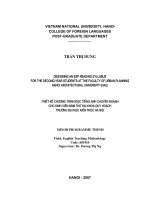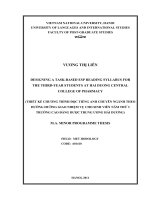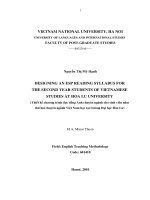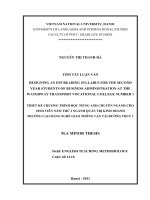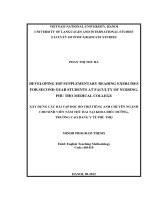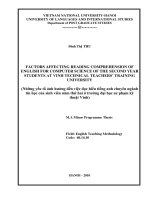(Luận văn thạc sĩ) factors affecting ESP vocabulary learning by the second year students at university of fire fighting and prevention
Bạn đang xem bản rút gọn của tài liệu. Xem và tải ngay bản đầy đủ của tài liệu tại đây (913.7 KB, 63 trang )
VIETNAM NATIONAL UNIVERSITY, HANOI
UNIVERSITY OF LANGUAGES AND INTERNATIONAL STUDIES
FACULTY OF POST-GRADUATE STUDIES
PHẠM THỊ THẢO
FACTORS AFFECTING ESP VOCABULARY LEARNING BY
THE SECOND-YEAR STUDENTS AT UNIVERSITY
OF FIRE FIGHTING AND PREVENTION
(Những yếu tố ảnh hưởng đến việc học từ vựng tiếng Anh chuyên ngành
của sinh viên năm thứ hai trường Đại học Phòng cháy Chữa cháy)
M.A MINOR PROGRAMME THESIS
Field: English Teaching Methodology
Code: 60140111
Hanoi – 2016
VIETNAM NATIONAL UNIVERSITY, HANOI
UNIVERSITY OF LANGUAGES AND INTERNATIONAL STUDIES
FACULTY OF POST-GRADUATE STUDIES
PHẠM THỊ THẢO
FACTORS AFFECTING ESP VOCABULARY LEARNING BY
THE SECOND-YEAR STUDENTS AT UNIVERSITY
OF FIRE FIGHTING AND PREVENTION
(Những yếu tố ảnh hưởng đến việc học từ vựng tiếng Anh chuyên ngành
của sinh viên năm thứ hai trường Đại học Phòng cháy Chữa cháy)
M.A MINOR PROGRAMME THESIS
Field: English Teaching Methodology
Code: 60140111
Supervisor: Dr. Nguyễn Huy Kỷ
Hanoi – 2016
DECLARATION
This paper is submitted in partial fulfillment of the requirements for The
Degree of Master of Arts in English Teaching Methodology. I confirm that this is
my own research, and that it has not been published or submitted for any other
degrees.
Hanoi, 2016
Phạm Thị Thảo
i
ACKNOWLEDGEMENTS
First and foremost, my sincere thanks are due to Dr. Nguyễn Huy Kỷ, my
supervisor for his continual, invaluable support, encouragement, guidance and
ideas.
I am grateful to all lecturers and the staff of the Faculty of Post-Graduate
Studies at University of Languages and International Studies-VNU for their useful
lecturers and guidance during my study.
I must also express my most sincere appreciation to my colleagues and
students at University of Fire Fighting and Prevention, who have assisted me with
data analysis and useful advice.
Lastly, my heartfelt gratitude goes to my beloved parents and husband whose
constant support and patience have encouraged me through the most difficult times.
ii
ABSTRACT
Vocabulary plays an important role in learning a foreign language, especially
in learning English for Specific Purposes. How to learn vocabulary efficiently is a
question to every learner as well as teacher at University of Fire Fighting and
Prevention. This research was carried out in order to help our students improve their
English for Specific Purposes vocabulary learning.
The aims of this study are to identify factors affecting students‟ English for
Specific Purposes vocabulary learning at University of Fire Fighting and Prevention
and suggest solutions to teach and learn English for Specific Purposes vocabulary
more effectively.
The study was undertaken with 100 second-year students and 4 teachers. On
the basic of data analysis, the findings show that the major factors affecting
students‟ English for Specific Purposes vocabulary learning of fire and rescue are
the intralexical factors, factors from students and teaching methods. Some solutions
are suggested to deal with these factors including encouraging students to develop
their self- study, providing students with different vocabulary learning strategies,
and improving teachers‟ techniques in teaching English for Specific Purposes
vocabulary.
It is hoped that the results of this study will help students and teachers at
University of Fire Fighting and Prevention learn and teach vocabulary of fire and
rescue better.
iii
LIST OF ABBREVIATIONS
ESP: English for Special Purposes
EFL: English as a Foreign Language
ESL: English as a Second Language
GE: General English
L1: First Language
L2: Second Language
UFFP: University of Fire Fighting and Prevention
iv
LIST OF CHARTS & TABLES
Chart 1: Students‟ attitude towards vocabulary learning
Chart 2: Students‟ evaluation on learning of ESP vocabulary
Chart 3: The element that students find the most difficult in learning fire and rescue
vocabulary
Chart 4: Students‟ difficulties in learning fire and rescue vocabulary
Table 1: Intralexical factors that affect vocabulary learning
Table 2: Students‟ purposes of learning ESP vocabulary
Table 3: Students‟ ways of learning a new word
Table 4: Students‟ ways of learning ESP vocabulary
Table 5: Teachers‟ ways of presenting new words
Table 6: Students‟ interest in ways of presenting new words
Table 7: Students‟ interest in ways of practicing new words
Table 8: Students‟ suggestions for better effects on learning fire and rescue
vocabulary
v
TABLE OF CONTENTS
DECLARATION…………………………………………………………………...i
ACKNOWLEDGEMENTS ………………………………………………………ii
ABSTRACT……………………………………………………………………….iii
LIST OF ABBREVIATIONS…………………………………………………….iv
LIST OF CHARTS AND TABLES ………………………………………………v
TABLE OF CONTENTS…………………………………………………………vi
PART I: INTRODUCTION ...................................................................................1
1. Rationale ...........................................................................................................1
2. Scope of the study .............................................................................................2
3. Objectives of the study......................................................................................2
4. Research questions ............................................................................................2
5. Methods of the study .........................................................................................3
6. Design of the study ...........................................................................................3
PART II: DEVELOPMENT ..................................................................................4
CHAPTER 1: LITERATURE REVIEW ..............................................................4
1.1. An overview of ESP.......................................................................................4
1.1.1. Definition of ESP ....................................................................................4
1.1.2. The roles of ESP teachers .......................................................................5
1.2. Vocabulary and ESP vocabulary ...................................................................6
1.2.1. Definition of vocabulary .........................................................................6
1.2.2. Classification of vocabulary and ESP vocabulary ..................................7
1.2.3. Aspects of word knowing .......................................................................8
1.3. Terminology .................................................................................................11
1.3.1. Definition of terminology .....................................................................11
1.3.2. Characteristics of terminology ..............................................................11
1.4. Some factors affecting vocabulary acquisition ............................................12
1.4.1. Intralexical factors ................................................................................12
1.4.2. The influence of first and other languages ...........................................13
vi
1.4.3. Vocabulary learning task ......................................................................14
1.4.4. Contextualization ..................................................................................15
1.4.5. Vocabulary learning strategies .............................................................15
CHAPTER 2: METHODOLOGY .......................................................................17
2.1. Setting of the study ......................................................................................17
2.1.1. Students and their background..............................................................17
2.1.2. Teachers and their teaching methods ....................................................18
2.1.3. Teaching materials and facilities ..........................................................18
2.2. Participants ...................................................................................................20
2.3. Data collection instruments..........................................................................21
2.4. Procedures of data collection and analysis ..................................................22
CHAPTER 3: DISCUSSION AND FINDINGS .................................................24
3.1. Data analysis and discussion of students‟ questionnaires ............................24
3.2. Data analysis and discussion of teachers‟ interviews ..................................34
3.3. Major findings ..............................................................................................36
PART III: CONCLUSION ...................................................................................39
1. Summary of major findings ............................................................................39
2. Concluding remarks ........................................................................................39
3. Pedagogical implications ................................................................................40
4. Limitations of the study ..................................................................................41
5. Suggestions for further study ..........................................................................42
REFERENCES ......................................................................................................43
APPENDIX 1: QUESTIONNAIRE ...................................................................... I
APPENDIX 2: INTERVIEW ................................................................................V
vii
PART I: INTRODUCTION
This part provides the background to the study and statement of the problem,
the objectives, the research questions, and the scope of the study as well as the
methods of the study. It also outlines the organization of the thesis.
1. Rationale
It is undeniable that English is a means of international communication in the
fields of science, technology, culture, education, economy, etc. It is not only the
native language of about 300 million of speakers around the world but also the
official language in many countries as well as second/ foreign language in many
nations in the world. In Vietnam, where people are carrying out the modernization
and industrialization, English is becoming more and more important. In teaching
and learning English as a foreign language in our country, English for Specific
Purposes has recently received a great deal of attention.
In Vietnam, English seems to be taught and studied in non-English
environment hence reading is an important means to get knowledge. As the result,
ESP materials used at most of the universities now are often reading materials with
topics in the specific areas and ESP textbook of University of Fire Fighting and
Prevention (UFFP) is not an exception. “Vocabulary learning has long had a
synergistic association with reading; each activity nourishes the other.” (Coady and
Huckin, 1997:2) and “Knowing words is the key to understanding and being
understood.” (Vermeer 1992: 147), therefore, if one wants to read ESP materials
well he needs to learn ESP vocabulary.
Vocabulary, which is considered as the base of a high building, is
indispensable in language learning. Teachers who have been teaching English in
general and English for Specific Purposes in particular must bear in mind that at the
beginning or in the end, vocabulary is always one of the biggest problems. At
UFFP, teaching and learning ESP vocabulary are really challenging. Vocabulary of
fire and rescue has long been considered a difficult and boring subject by many
students at the university. For ESP teachers, correspondingly, it is a difficult task to
1
get students involved in vocabulary learning even they devoted a plenty of time to
vocabulary teaching, the results have been disappointing. The question posed for
ESP teachers now is how to meet the needs of ESP learners, especially the needs of
improving their vocabulary acquisition.
Facing this situation, the teachers of English at UFFP would like to do
something new to help students overcome these difficulties. Being one of the
teachers there, I would like to do a study to identify factors that most affect
students‟ vocabulary learning of fire and rescue, to claim a more satisfactory
standing for ESP vocabulary for the second-year students, as a result, the title of the
minor thesis goes as:
“Factors affecting ESP vocabulary learning by the second-year students at
University of Fire Fighting and Prevention.”
2. Scope of the study
The study mainly focuses on the investigation of factors most affecting ESP
vocabulary learning by the second-year students at University of Fire Fighting and
Prevention, and then suggests some techniques to help them improve their ESP
vocabulary.
3. Objectives of the study
In this study, two objectives were involved as follow:
- To investigate the current situation of teaching and learning ESP vocabulary
in order to find out the factors affecting students‟ ESP vocabulary learning at UFFP.
- To give some recommendations to improve the quality of teaching and
learning ESP vocabulary at UFFP.
4. Research questions
The research is carried out in an attempt to answer the following questions:
1. What are the factors affecting students‟ learning of ESP vocabulary at
UFFP?
2. What solutions should be suggested to help the students learn ESP
vocabulary more effectively?
2
5. Methods of the study
The study was conducted using both quantitative and qualitative methods
including questionnaires and interviews. The quantitative data was collected
through a survey delivered to 100 second-year students who have already
completed their ESP course and qualitative data was obtained through interviews
with four ESP teachers.
6. Design of the study
The minor thesis consists of three parts: Introduction, Development and
Conclusion.
The first part includes the rationale, the objectives, the methods, research
questions, and the scope of the study as well as the organization of the thesis.
The second part consists of three chapters. Chapter 1 discusses the theoretical
background of the research, which is related to the issues relevant to the topic of the
research. Chapter 2 investigates the setting of the study, the participants, data
collection instruments as well as procedures of data collection and data analysis.
Chapter 3 deals with data analysis, discussion and major findings.
The last part- Conclusion- restates the findings of the study, the concluding
remarks and discusses the implications and limitations of the study as well as
proposes some suggestions for further research. Following this part are References
and Appendix.
3
PART II: DEVELOPMENT
CHAPTER 1: LITERATURE REVIEW
Since the mid-1980s, various studies of vocabulary acquisition and related
areas of lexical research in second language acquisition have been carried out. The
role of vocabulary in second language learning and teaching has been given greater
interest (Coady and Huckin, 1997). In this chapter, the important role of vocabulary
in second language teaching and learning as well as classification of vocabulary
learning and factors that affect vocabulary learning are presented and commented
upon.
1.1. An overview of ESP
1.1.1. Definition of ESP
According to Hutchinson and Walters (1987), ESP is an approach to
language teaching in which all decisions as to content and methods are based on the
learners‟ reason for learning. This means that ESP does not involve a particular kind
of language teaching material or methodology. He clarifies that ESP is not a matter
of teaching „specialized variety of English‟. Teaching ESP should be based on the
first instance on principles of effective and efficient learning.
Robinson‟s definition is based on two key defining criteria and a number of
characteristics that are generally found to be true of ESP. The key criteria are that
ESP is “normally goal-directed” and that ESP courses develop from a needs
analysis, which “aims to specify as closely as possible what exactly it is that
students have to do through the medium of English” (Robinson: 1991:3).
In an understandable way, Evans and St John (1998: 2-5) use „absolute‟ and
„variable‟ characteristics to clarify the term ESP. Their definition is as follows: „1.
Absolute characteristics: ESP is designed to meet specific needs of the learner; ESP
makes use of the underlying methodology and activities of the discipline it serves;
ESP is centered on the language (grammar, lexis, and register), skills, discourse and
genres appropriate to these activities. 2. Variable characteristics: ESP may be
related to or designed for specific disciplines; ESP may use, in specific teaching
4
situations, a different methodology from that of general English; ESP is likely to be
designed for adult learners, either at a tertiary level institution of in a professional
work situation. It could, however, be used for learners at secondary school level;
ESP is generally designed for intermediate or advanced students. Most ESP courses
assume basic knowledge of the language system, but it can be used with beginners.‟
This description broaches the ESP as satisfaction for a wide range of learner and
their needs. It consists of activities and some language factors suitable for the
learners.
From the definitions above, it is clear that ESP courses are purposeful and
aim at the successful performance of occupational roles by an individual or a group
whose need is considered to be a distinguished feature to those of GE.
1.1.2. The roles of ESP teachers
Whether the ESP teacher should master the materials or content of the
subject matter seems a debating issue. Littlewood (1981: 51) says that a language
teacher is expected “to perform in a variety of roles, separately or simultaneously”.
These roles may include an instructor, a syllabus designer, a material
writer/provider, and even a friend. Hutchinson and Waters (1987: 157) think that
„ESP teachers do not need to learn specialist subject knowledge‟. They list three
requirements of the ESP teachers as follows:
- A positive attitude towards the ESP content;
- A knowledge of the fundamental principles of the subject area;
- An awareness of how much they probably already know.
Dudley-Evans and St John (1998) argue that ESP teaching is extremely
varied. They continue to say that the ESP teacher should perform different roles:
teacher, course designer, collaborator, researcher, and evaluator.
The first role as 'teacher' is identical with that of the 'General English'
teacher. However, due to his/her lack of knowledge, the ESP teacher has to work
with teachers of other subjects or field specialists. This collaboration does not have
to end at the development stage and can extend as far as teach teaching, a possibility
5
discussed by Johns et al. (1988). When team teaching gets difficult, the ESP
Teacher must collaborate more closely with the learners, who will generally be
more familiar with the specialized content of materials than the teacher him or
herself.
Both 'General English' teachers and ESP teachers are often required to design
courses and provide materials. However, providing materials is not an easy task due
to the fact that materials in one field are numerous. This makes the ESP teacher
become a researcher. He/She has to develop authentic materials that may be suitable
for their learners. The final role as 'evaluator' is perhaps the role that ESP teachers
have neglected most to date.
The ESP practitioner is often involved in various types of evaluation: testing
the students, evaluating the courses and the teaching materials. (Dudley-Evans and
St John, 1998: 16). Doing these kinds of evaluation, especially through discussion
and on-going needs analysis can be used to adapt the syllabus.
In brief, ESP teachers as a practitioner have many roles in ESP teaching. Hutchison
and Waters (1987), hence, assumed that “adaptability” and “flexibility” are the
foremost requirements of an ESP teacher.
1.2. Vocabulary and ESP vocabulary
1.2.1. Definition of vocabulary
There have been different definitions of vocabulary. Each linguist gives his
own definition of vocabulary depending on the criteria that he considers the most
important in terms of linguistics, semantics, lexicology, etc. Penny Ur defined
vocabulary as “the words we teach in the foreign language. However, a new item of
vocabulary may be more than a single word, a compound of two or three words or
multi-word idioms” (Ur, 1996). A similar definition from Richards and Platt is that
vocabulary is “a set of lexemes, including words, compound words and idioms”
(Richards and Platt, 1992). These statements indicate that vocabulary is the total
number of all the words that a language possesses, including a single word, two or
6
three word items expressing a single idea and multiword idioms of which meaning
cannot be deduced from the analysis of the component words but only understood in
1.2.2. Classification of vocabulary and ESP vocabulary
Vocabulary can be classified in different ways according to different criteria.
Semantically, it can be divided into notional words (name objects, actions,
qualities, etc.) and functional words (particles, articles, preposition, etc.).
Grammatically, vocabulary is categorized into different parts of speech such as
nouns, verbs, adjectives, etc.).
In particularly, as many language learners notice, vocabulary can be divided
into active vocabulary and passive vocabulary. The active vocabulary consists of
words which can be used very often, both in speaking and writing by the learners.
The passive vocabulary includes the words that can be recognized and understood
easily when occur in context but may not be used correctly and effectively in reality
by the learners.
Recently, according to some methodologists of the Communicative
Language Teaching, vocabulary can be split into productive vocabulary and
receptive vocabulary. The productive vocabulary is concerned with the words that a
learner can use effectively to express his/her ideas both in speaking and writing
forms. The receptive vocabulary is the words that help a leaner to receive and
understanding information in listening and reading.
According to Fraser (2005), ESP vocabulary can be divided into three types:,
and general vocabulary, academic vocabulary and technical vocabulary. General
vocabulary consists of high-frequency words that are used in daily life as well as in
a specific field. Academic vocabulary includes words that are used commonly in a
variety of academic texts or discourse. Technical vocabulary is most obviously
associated with specialized texts or discourse. These words have their specific
meanings and they seem to be very uncommon to the people who are not related to
their fields of meaning. Technical vocabulary can be sub-divided into three smaller
branches:
7
- Fully technical vocabulary
- Crypto technical vocabulary
- Lay-technical vocabulary
Fully technical vocabulary comprises those words whose meaning is clearly
technical. They are specific to the field and not likely to be known in general
language e.g. hypertension, obesity, hepatitis … Crypto technical vocabulary
consists of polysemous words like “transmitter” which could be said to be „cryptic”
in that they have a hidden technical meaning. Lay technical vocabulary comprises
those terms which are obviously technical but are likely to be known by the
layperson, e.g. bacteria, toxicity …
As foreign language teachers, we need to understand these classifications so
that we can help students extend their vocabulary with more productive and active
words. As ESP teachers, we need to help students extend, memorize and use their
ESP vocabulary effectively in their concerned subjects.
1.2.3. Aspects of word knowing
Vocabulary acquisition is an important goal that one needs to achieve in his/
her study of a second language. Nation (2001) states that: “It is wise to direct
vocabulary learning to more specialized areas when learners have mastered the
2000-3000 words of general usefulness in learn and be taught judgment about
vocabulary and its use such as vocabulary aspects, which words are worth focusing
on and at what time, during class or independent study time, etc.”
According to Penny Ur (1996), when vocabulary is introduced to learners,
pronunciation and spelling, word form, grammar, collocation, aspects of meaning,
word formation need to be taught.
1.2.3.1. Word form
When learning vocabulary students should be introduced its pronunciation
and its spelling. To many students, the complex relationship between sound and
spelling in English seems to make the language inexplicable. It is easy to
understand when we consider the number of homophones in English such as:
8
weight! wait, sole/ soul, and the number of similar forms that differ in their
pronunciation like hurry/ humor.
1.2.3.2. Grammar
There are two main pedagogic issues involved: the highlighting of regular
and irregular forms, and the role of source books in allowing learners to be siftedsufficient. In the classroom, the new item is not obviously covered by general
grammatical rule, grammar will need to be introduced or examined. The teachers
need to clarify regular forms and common regular forms for students. When a new
word is taught, for example, we might also give its past form such as: buy/ bought
and it is transitive or intransitive, when a noun such as a person is taught, it should
be given its plural form as people.
1.2.3.3 Collocation
Collocation is the way in which words are used together regularly in a
specific language. It refers to the restriction on how words can be used together in
right contexts. Thus, this is another piece of information about a new item, which
may be worth teaching. For example, you throw a ball but toss a coin. We can talk
about thick fog and dense fog, thick smoke and dense smoke with the same meaning.
However, we cannot say dense hair instead of thick hair.
1.2.3.4. Aspects of meaning
Aspects of meaning include denotation, connotation, appropriateness and
meaning relationship.
The denotation meaning refers to or point out things, concepts. This is often
the sort of definition given in dictionaries such as "cat" denotes a small animal with
soft fur, often kept as a pet or for catching mice.
Connotation of a word is less obvious component of its meaning. This is
association, or positive and negative feelings the word evokes which may not be
indicated in a dictionary definition. Connotation includes stylistic, affective,
9
evaluation, intensifying value, pragmatic communicative values, the word acquires
by virtue of where, when, how and by whom, for what purpose and in what context
it is or it may be used.
Appropriateness is more subtle aspect of meaning that indicates whether a
particular item is appropriate one to use in a certain context or not. Thus, it is useful
for a learner to know whether a certain word is very common, or relatively rare or
taboo in a polite conversation, or tends to be used in writing but not in speaking, or
is more suitable for a formal than informal discourse or belongs to a certain dialect.
It is necessary to list aspects of meaning in the sense of meaning
relationships. This can also be useful in vocabulary teaching and learning. They
show how the meaning of one item relates to the meaning of others. These are
various relationships and here are some of the main ones like synonyms, antonyms,
hyponyms, co- hyponyms or co- ordinates, super ordinates, and translation.
1.2.3.5. Word formation
Word can change their shape and their grammatical value. Vocabulary items
whether one-word or multi-word can often be broken down into their components
"bits". Students need to know facts about word formation and how to use words to
fit different grammatical contexts.
For their parts, students should be taught the common prefixes and suffixes
and how they work. For example, if learners know the meaning of "sub", "un" and
"able", this will help them guess the meaning of words such as "substandard",
"uncomfortable", and "enable". However, students should be warned that in many
common words the affixes no longer have obvious connection with their root
meaning (for example: "consider" -> "considerable")
Another way that vocabulary items are built is by combining two words: two nouns,
or a gerund and a noun, or a noun and a verb to make one item: a single compound
word or two separate (for example: "book list"," sitting room")
10
1.3. Terminology
1.3.1. Definition of terminology
Terminology is defined as “the process of compiling, describing, processing
and presenting the terms of special subject fields in one or more languages”. It is
“not an end itself, but addresses social needs and attempts to optimize
communication among specialists and professionals by providing assistance either
directly or to translator or to committees concerned with the standardization of a
language”. (Cabré, 1999)
Terminology may be considered as a system of words or symbols to name a
typical phenomenon or phenomena in natural and social research fields in a
scientific way. It also includes necessary methods in language contents and study to
reach sufficient and suitable terms. Additively, there may be terms which are
accepted and used by a large number of individuals and terms which are admitted
by a restricted group of people.
1.3.2. Characteristics of terminology
Many linguist including Nguyen Thien Giap (1985) share the idea that
terminology has at least three important features: accuracy, systematization, and
internationality. Terminologies of fire and rescue also have these features.
Accuracy
A terminology should express a scientific concept or definition concretely
and precisely in order to avoid misunderstanding one concept for another.
Terminologies exist without connotative, emotional meanings and avoid polysemy,
synonym and antonym. In other words, one terminology expresses a particular
meaning, in turn, with a meaning only a specific terminology expresses. In the fire
and rescue area, this characteristic is clearly seen. For example: combustion
reaction, vaporization, rescue, ionization, etc.
Systematization
Systematization is considered to be of the most important features of
terminology. Every field of science has its own limited system of concepts which
are denoted by certain terminologies and the value of each terminology is
determined by its relationship with other terminology in the same system. As the
11
result, terminology loses its value when being isolated from its system. Generally, a
terminology has to be a dependent member of its system. For instance: ionization
smoke detectors and optical smoke detectors, fire inspection, fire safety code,
inspection tour, etc.
Internationality
The internationality is recognized in both form and meaning of terminology.
With respect to such characteristics of terminology in term of meaning, terminology
denotes common scientific concepts shared and equally understood by speakers of
different cultures. This feature is an important property that helps distinguish
terminology from other layers of vocabulary such as slang, dialect, etc. Terms
denote universal concepts of a certain subject, whereas normal lexical items are
confined to various limits of expression, context, and culture differences. The
internationality is also seen in the form of terms. It is interesting to know that many
terms used by different countries have similar phonetic form. The internationality of
terms helps promote and accelerate the irreversible trend of global integration today
in term of language as well as other fields.
1.4. Some factors affecting vocabulary acquisition
1.4.1. Intralexical factors
The key factors that affect the learning of a lexical item and make
the acquisition of vocabulary difficult are intralexical factors. According to Laufer
(1997), the factors that affect the learnability of lexical items include
pronounceability (phonological or suprasegmental features), orthography, length,
morphology, including both inflectional and derivational complexity that
increase the vocabulary learning load, similarity of lexical forms (e.g.
homonyms),
grammar,
i.e.
part
of
speech,
and
semantic
features (e.g. abstractness, specificity and register restriction, idiomaticity
and multiple meaning). Table 1 gives an overview of the intralexical
factors
and
their
effect
on
vocabulary
learning
difficulty-inducing factors and factors with no clear effect)
12
(facilitating
factors,
Facilitating factors
Difficulty-inducing factors
Familiar phonemes
Presence of foreign phonemes
Phonotactic regularity
Phonotactic irregularity
Fixed stress
Factors with no
clear effect
Variable stress and vowel
change
Consistency of sound-
Incongruency in sound-script
script relationship
relationship
Word length
Inflexional regualarity
Inflexional complexity
Derivational regularity
Derivational complexity
Morphological
Deceptive morphological
transparency
transparency
Synformy
Part of speech
Concreteness/
abstractness
Generality
Specificity
Register neutrality
Register restrictions
Idiomaticity
One form for one
meaning
One form with several meanings
Table 1: Intralexical factors that affect vocabulary learning (Laufer, 1997: 154)
1.4.2. The influence of first and other languages
L2 vocabulary acquisition is different from L1 vocabulary acquisition
because an L2 learner has already developed conceptual and semantic
systems linked to the L1. This is why L2 acquisition, at least in its initial stages,
often involves a mapping of the new lexical form onto an already
existing conceptual meaning or translational equivalent in L1. The role of
13
L1
in
between
this
process
languages:
varies
depending
although
in
on
some
the
cases
degree
it
of
may
equivalency
facilitate
the
acquisition or use of L2 lexical items, in others it will create an obstacle.
This may occur in the process of acquisition, in recalling and using
previously learnt lexical items, or in attempts of constructing a complex
lexical al item that has not been learnt as a unit. By making cross-linguistic
comparisons (i.e. by contrastive analysis) one can often predict difficulties caused
by
interference
of
the
L1
that
learners
may
encounter
when
learning the target language. Namely, the learner ‟s approach to L2
learning is based on an „equivalence hypothesis‟: „the learner tends to
assume that the system of L2 is more or less the same as in his L1 until he
has
discovered
readiness
to
that
transfer
it
is
not‟
may also
(Ringbom,
be
1987:
influenced
135).
by his
The
learner‟s
perceptions
of
linguistic and cultural distance. Forming a kind of equivalence hypothesis enables
learners
to
learn
an
L2
without
having
to
go
all
the
way
back
to learning how to categorize the world.
1.4.3. Vocabulary learning task
Williams and Burden (1997) claim that the learning task includes the
materials being learned (such as the genre of a piece of reading) as well as the goal
the learner is trying to achieve by using these materials (such as remembering,
comprehending or using language).
In practice, it appears to refer to the idea of some activities designed to
engage the learner in using the language communicatively or reflectively in order to
arrive at an outcome other than that of learning a specified feature of the L2. A task
can be a real-world activity or a contrived, pedagogic activity (Nunan, 1989), as
long as the process of completing the task corresponds to that found in discourse
based on the exchange of information. (Ellis, 1994)
Different types of task materials, task purposes, and tasks at various
difficulty levels have various effects on the learners‟ vocabulary acquisition. For
example, learning words in a word list is different from learning the same words in
14
a passage. As well, remembering a word meaning is different from learning to use
the same word in real life situations.
1.4.4. Contextualization
Davies and Pearse (2000: 63) state that „an appropriate context helps learners
begin to understand the use of the item as well as its basic meaning. The item is
associated with a certain type of context or situation.‟
„If learners have to perform certain activities on unfamiliar words in texts, there is a
good chance of retaining the words. The activities comprise guessing meaning from
context and from word to word, verifying meaning by checking in a dictionary, and
analysis of the word form to recognize relationships between the new word and
others already known.‟ (Hedge, 2000: 120)
It is agreed that vocabulary is better acquired not in an isolated form but in a
context or situation. Although a learner has grasped the pronunciation, spelling and
meaning of a word, a text with the appearance of that word will help deepen the
word storage in the learner‟s mind.
1.4.5. Vocabulary learning strategies
According to Hedge (2000: 19) learning strategies are „techniques used by
learners to deal with input, assimilate new language, store, retrieve, and practice
using it‟. Teachers and textbook writers „have attempted both to find ways of
improving the strategies learners already have and to raise their awareness about
others they might develop‟. (Hedge, 2000: 19)
Vocabulary learning strategies are one part of language learning strategies
which in turn are part of general learning strategies (Nation, 2001)
Intaraprasert (2004) sees vocabulary learning strategies as “any set of techniques or
learning behaviors, which language learners reported using in order to discover the
meaning of a new word, to retain the knowledge of newly-learned words, and to
expand their knowledge of vocabulary.” According to Cameron (2001), vocabulary
learning strategies are the actions that learners take to help themselves understand
and remember vocabulary items.
15
With reference to the definitions of the term “vocabulary learning strategies”
above, we can conclude that this term has been used to refer to the purposeful steps,
actions or mental processes that the learners employ, more or less consciously, with
the purpose to facilitate vocabulary learning. These processes lead to the
interventions that enhance vocabulary skills in the target language.
16


